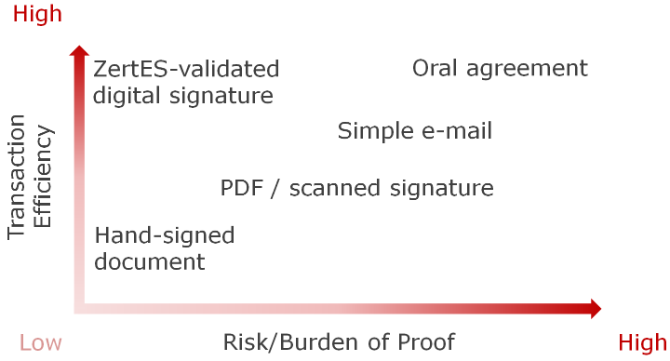[1]
A question I am asked frequently is whether it is permissible to sign legally binding documents with a PDF or scanned signature, e.g. with DocuSign1. The reason for wanting to do so could be the physical distance between the contracting parties, time pressure, or the desire to streamline and digitalize processes.
[2]
Generally, Swiss law follows the principle of freedom of contract2. This means that unless there are mandatory legal requirements, the contracting parties are free with regard to form (art. 11 Code of Obligations [CO]) and content (art. 1 CO) of their agreements. By law the conclusion of an agreement requires both offer and acceptance by the contracting parties (art. 3 et seq. CO). Where the law requires that a contract be concluded in writing3, it must be signed by all persons on whom it imposes obligations (art. 13 CO). Signatures must be written by hand (art. 14 (1) CO). (Only) an authenticated electronic signature according to the Swiss Signature Act (ZertES)4 is deemed to be equivalent to a handwritten signature (art. 14 (2bis) CO). This means that if the law requires your handwritten signature, you must physically sign the document or, alternatively, you can append your ZertES-validated digital signature to it.5
[3]
For the largest part of agreements concluded under Swiss law no signature is required. They can be concluded orally. If an agreement can be concluded orally, it can also be concluded by electronic means such as, for instance, e-mail, chat service, or text message. Of course you can always opt to add your signature, if you so desire. Hence, the question is not whether it is permissible to commit to an obligation with a PDF or scanned signature but rather what risk of proof the contracting parties are willing to take by choosing not to sign their agreement by hand-written signatures or a ZertES-validated digital signature.
[4]
Pursuant to art. 8 Civil Code (CC), unless the law provides otherwise, the burden of proof rests with the party claiming an alleged fact. Having to prove an oral commitment before a court of law is significantly harder than if you can submit hand-signed original evidence. So there is a trade-off between transaction efficiency and risk (burden) of proof:
[5]
The above chart shows the different positions:
- Oral agreement: it is efficient but difficult to prove.
- Simple e-mail: it is quite efficient but there is a risk the e-mail is fake (i.e. it is easy to forge an e-mail text).
- PDF signature: it is less efficient (i.e. you need to print, sign and scan the document but you can exchange it by e-mail) but there is a risk the signature was copy-pasted.
- Signature by hand: it is not efficient (i.e. you need to print and sign the document, and exchange it by postal mail) but it is evidence-proof according to the law.
- ZertES-validated digital signatures: it is both efficient and evidence proof. Unfortunately, ZertES-validated digital signatures are expensive6 and not widely distributed.
[6]
So ultimately, if you decide to sign a document electronically without a ZertES-validated digital signature the decision to be taken is how much risk you are willing to assume. It is a business not a legal decision.
Daniel Ronzani
- 1 https://www.docusign.com/.
- 2 Peter Gauch/Walter R. Schluep/Jörg Schmid, Schweizerisches Obligationenrecht Allgemeiner Teil, Band I, Schulthess Verlag, 9. Auflage, Zürich 2016, Rz. 612 ff.
- 3 E.g. assignment of a claim (art. 165 para. 1 CO).
- 4 Federal Act on electronic signatures, ZertES, SR 943.03.
- 5 For a general overview on digital signatures see: Simon Schlauri, Elektronische Signaturen, Band 19 ZIK, Zürich/Basel/Genf 2002.
- 6 Approx. CHF 125.–/year.






